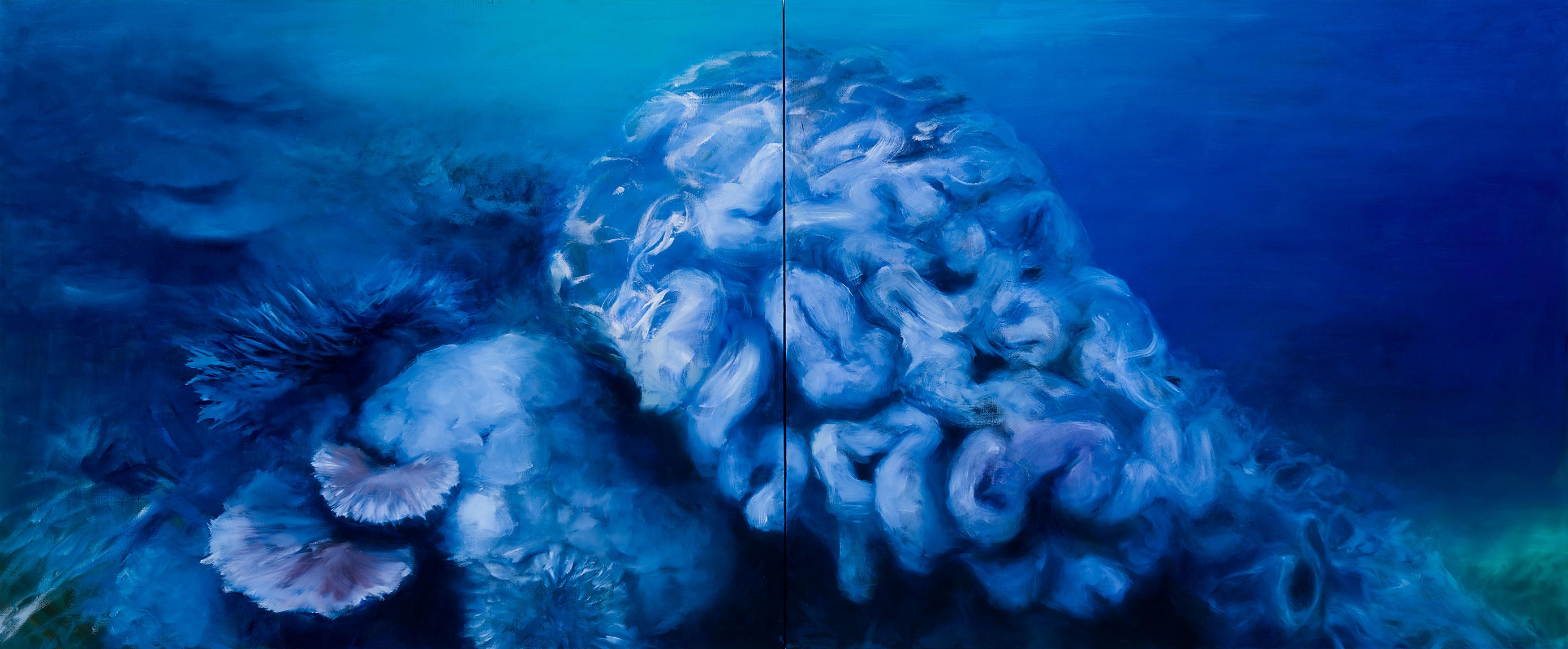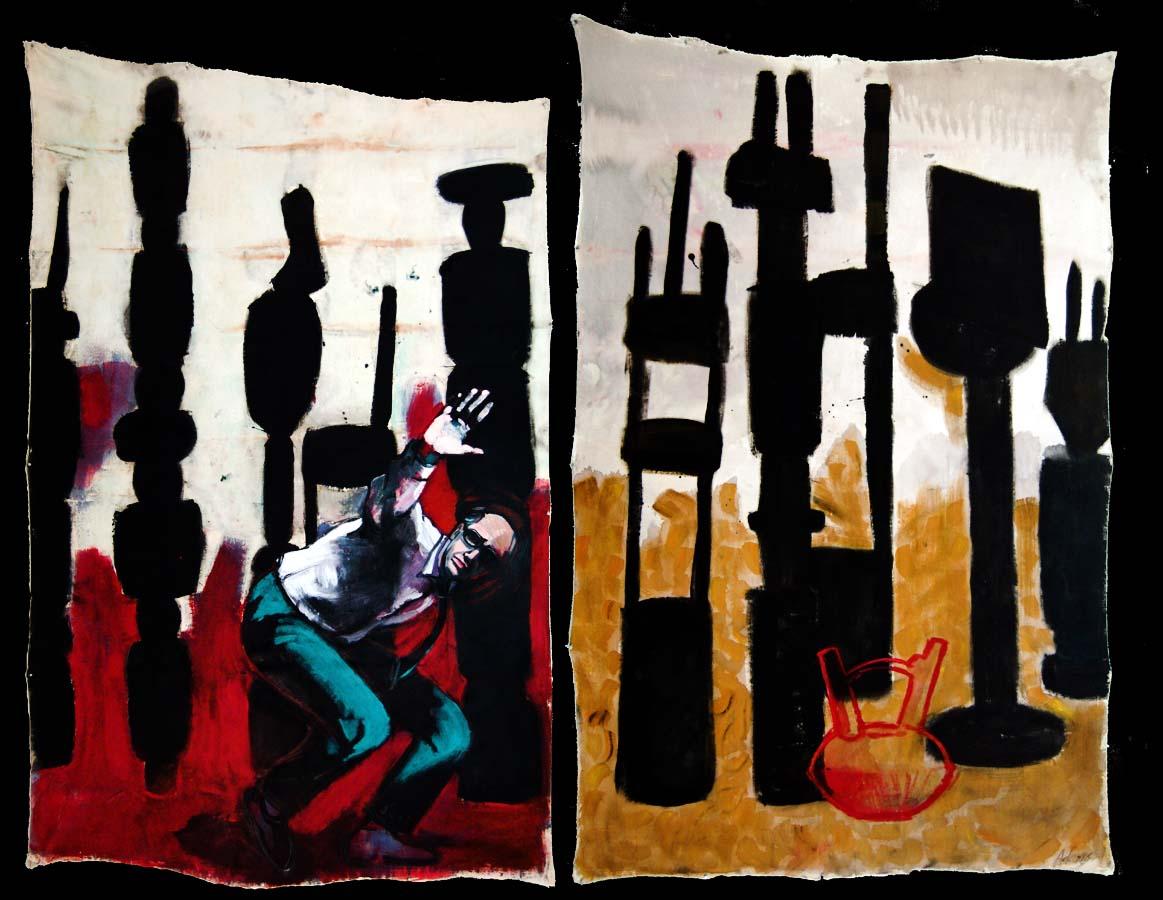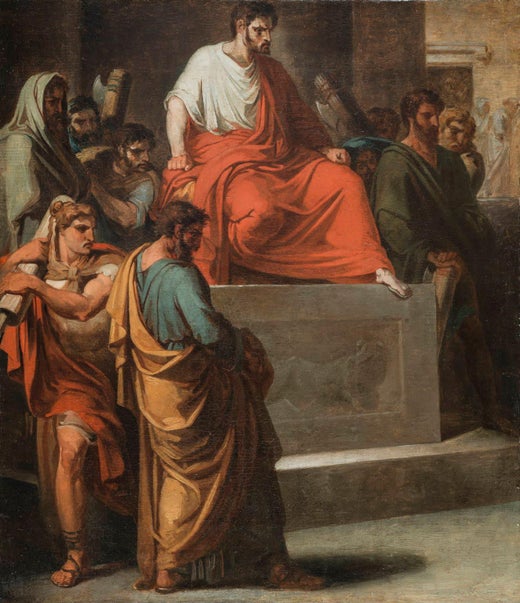Vincenzo CamucciniItalian artist Camuccini Neoclassical Roman History Painting 19th oil canvas1800-1802
1800-1802
About the Item
- Creator:Vincenzo Camuccini (1771 - 1844, Italian)
- Creation Year:1800-1802
- Dimensions:Height: 15 in (38.1 cm)Width: 12.9 in (32.77 cm)
- Medium:
- Period:
- Condition:
- Gallery Location:Florence, IT
- Reference Number:1stDibs: LU1240210334612
Vincenzo Camuccini
Vincenzo Camuccini, sometimes also referred to as Camucini, was one of the most important Italian Neoclassicists and history painters, despite having lived in a period in which romantic culture had taken hold within the European artistic-literary landscape. It was Pietro, Camuccini's brother, who became famous for cleaning up Michelangelo's Last Judgment in 1824-25, and who carried out various restorations for the Borghese, to push Vincenzo towards art. Every day, Camuccini visited Raphael's Rooms and trained himself to copy the style of that period. In adolescence, he first went to the school of Domenico Corvi and later to the most famous of David. In addition to studying the masterpieces of classical sculpture and Renaissance painting, Camuccini was very fond of representing everyday reality, portraying both nature and the people of the street to study their expressions and give their paintings as realistic a note as possible. Probably in this, the painter was influenced by Romanticism, very attentive to the beauty and grandeur of nature, in all its details. His interest in the realistic rendering of the subjects led him to attend hospital environments to perform studies on corpses. After spending years copying the greatest of art history, Camuccini began to create works of his own invention. His fame grew over the years, leading him to receive increasingly important commissions, up to the appointment by Pope Pius VII as director general of the Fabbrica di San Pietro and to the superintendency of the Vatican Museums, which over the years had been illustrious by artists such as Michelangelo, Maderno and Bernini. For the pontiff, he created The Incredulity of St. Thomas and a St. Simon and Judas, two large canvases for St. Peter's Basilica. At the same time, Vincenzo Camuccini opened an important atelier in Rome, frequented by many Italian and foreign artists.
- ShippingRetrieving quote...Ships From: Florence, Italy
- Return PolicyA return for this item may be initiated within 2 days of delivery.
- Dutch Bamboccianti Jacob van Huchtenburg Rome Market 1674 Oil canvasBy Jacob Van HuchtenbergLocated in Florence, ITThe Market in Piazza del Popolo is a work by the Flemish painter Jacob van Huchtenburg, born in Haarlem and present, in the early 1660s, in Rome, in close contact with his compatriot...Category
1670s Other Art Style Still-life Paintings
MaterialsOil, Canvas
- Signed M. Maccari Post Impressionist Figurative Painting dated 1956 oil canvasBy Mino MaccariLocated in Florence, ITThe painting (oil on canvas, 44.5 x 35 cm; with wood frame 64 x 54,5 cm) represents a moment on deception. It's signed Maccari on the bottom left, and it's dated 1956 and titled "ins...Category
1950s Post-Impressionist Figurative Paintings
MaterialsOil, Canvas
- Tuscan Figurative Genre Scene painting 20th century oil on canvasLocated in Florence, ITThe artist of this painting is unknown but it can be ascribe to a Tuscan movement of the 20th century inspired by 19th century art like Verismo (as we can deduce by the clean and not...Category
20th Century Folk Art Figurative Paintings
MaterialsCanvas, Oil
- Tuscan Figurative Genre Scene painting 20th century oil on canvasLocated in Florence, ITThe artist of this painting is unknown but it can be ascribe to a Tuscan movement of the 20th century inspired by 19th century art like Verismo (as we can deduce by the clean and not...Category
20th Century Folk Art Figurative Paintings
MaterialsCanvas, Oil
- Tuscan Historical Figurative painting 20th century oil on canvasLocated in Florence, ITThe artist of this painting is unknown, but it is a direct derivation of "The Stagecoach of the Grand Duke" by Raffaello Sorbi, now held in a private collection in Milan, as we can s...Category
20th Century Folk Art Figurative Paintings
MaterialsCanvas, Oil
- G Negri called Il Boccia Baroque Figurative Painting 17th century oil canvasBy Girolamo Negri called Il BocciaLocated in Florence, ITOil on canvas, 62 x 51 cm (without the frame) Even if on the background there is an attribution to “Francesco Gessi pupil of Guido Reni” by the bolognese art historian Guido Zucchini (dated 1945), recent studies are tending to add it to the corpus of Girolamo Negri called Il Boccia (Bologna 1648-1718) due to lots of similarities with his style (the pale and warm palette chosen, the profile) The painting represents a lady on profile wearing a brown turban, a yellow clock...Category
Late 17th Century Baroque Figurative Paintings
MaterialsCanvas, Oil
- "Ebbing Reef" Corals, Large Scale Contemporary Seascape Oil Painting (deep blue)By Karen MarstonLocated in New York, NY60"x144" large scale painting, oil on canvas, created on two joined canvases. The deep blue palette gives a sense of underwater space in this grand depiction of coral reefs. Artist, Karen Marston presents this endangered species in a grand scale to show its beauty and importance to our environment. Karen Marston is a painter living and working in Brooklyn, NY. Her work has been seen in a number of solo exhibitions in New York City. In addition to her 2018 show Harbingers, at the Owen James Gallery in Soho, other recent solos include: 2017’s To Embrace the Whole Sky with the Mind, at Station Independent Projects on the Lower East Side, Demeter’s Wrath in 2016 at the Owen James Gallery and Storm Watch...Category
2010s Contemporary Landscape Paintings
MaterialsOil, Canvas
- HOMAGE TO THE CLASSICSBy Ferjo, Fernando de Jesus OliveiraLocated in Aventura, FLOriginal oil painting on canvas. Hand signed on front by the artist. Canvas is stretched. Artwork is in excellent condition. Certificate of authenticity included. All reasonable...Category
21st Century and Contemporary Surrealist Figurative Paintings
MaterialsCanvas, Oil
- Island of Broken Toys (diptych)Located in Burlingame, CA'Island of Broken Toys' 2019, a diptych contemporary oil on canvas painting by Tamera Avery, whose paintings are created with wit and wisdom. Avery's work...Category
21st Century and Contemporary Contemporary Portrait Paintings
MaterialsCotton Canvas, Oil
- Dust Ford KingLocated in Santa Monica, CAIn this series of portraits, Birch materializes enigmatic, ectoplasmic figures in his psychologically charged canvases linking sympathies between external forces and interior emotion...Category
2010s Contemporary Figurative Paintings
MaterialsCanvas, Linen, Oil
- EscandaloLocated in Miami, FLJohannes Boekhoudt is a Dutch artist born on October 20, 1966. In 1973, Boekhoudt immigrated with his parents to Costa Rica, eventually working as a commercial and air ambulance pilo...Category
2010s Abstract Abstract Paintings
MaterialsOil, Canvas
- Oil Painting / Photorealism / Figurative Art / Human Figure /MuseumBy Bruce AdamsLocated in Buffalo, NYBruce Adams was a painter, art educator, and writer. Born in Buffalo, N.Y., in 1952, he received a B.S. in 1976 and an M.A. in 1983 from Buffalo State College. Adams’s work is includ...Category
1980s Contemporary Figurative Paintings
MaterialsCanvas, Oil






